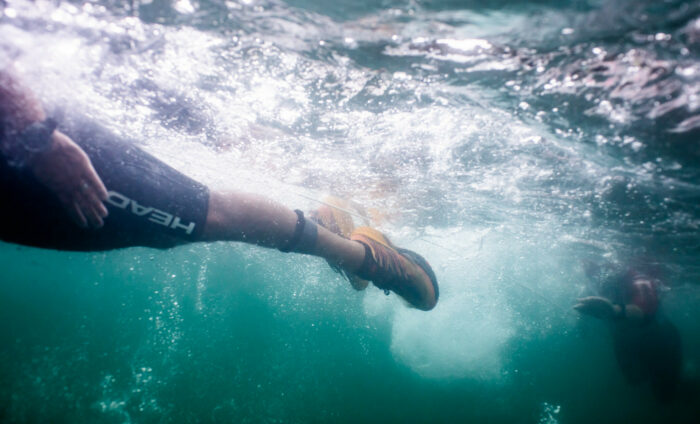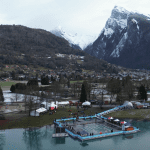
How much do shoes slow you down when you’re swimming?
The first time I swam in shoes, I discovered my feet were more important to swimming than I thought, even though I don’t kick much. Until the sensation was removed, I hadn’t realised how much you feel the water with your feet. As well as the obvious drag, shoes disrupt the balance and rhythm of your stroke.
To be fair, after a few swims, you get used to it. But there is no doubt it is slower swimming with shoes than without. The questions is, how much? And does this mean rethinking our approach to swimrun events? I recently had the chance to try it out when I took part in an invitational event, The Henley Mile Unltd. The aim was to swim the Henley Mile as many times as possible in six hours, albeit with a short break for lunch. We swam downstream only and had to run back to the start each time.
I swam the first six miles with running shoes, and these were my times:
· Mile 1: 24:53
· Mile 2: 26:26
· Mile 3: 26:40
· Mile 4: 27:59
· Mile 5: 28:28
· Mile 6: 29:24
Clearly, I didn’t pace this very well. Also, I didn’t eat enough and struggled because of that towards the end. However, the shoes definitely contributed to slowing me down. I found I was working harder than I normally would on a long distance swim and was getting frustrated because the effort wasn’t propelling me through the water as fast as I felt it should be.
After the sixth mile, I had a break of about 45 minutes, refuelled, removed my shoes and changed out of my swimrun wetsuit into a standard swimming wetsuit. I decided to run barefoot instead. These are my times for the final two miles I swam:
· Mile 7: 22:28
· Mile 8: 24:50
The seventh mile felt amazing. I was unleashed. On the 8th mile, I knew I wasn’t going to try for a ninth, so turned onto my back and drifted the last 50m, watching the clouds, and I was still 3 seconds faster than my first mile. But roughly speaking, it looks like shoes added somewhere between 2:30 and 7:30 minutes over the mile – which is around 9 to 28s per 100m or 10 to 30%. It’s a huge difference.
Some of the difference could be down to the wetsuit. A shortie swimrun wetsuit will never be as fast as swimming wetsuit. On the other hand, I was tired after 6 miles of swimming (and another 6 of running), so that will have slowed me down. I assume any benefit from changing wetsuits was wiped out by fatigue.
What does this mean for swimrun?
Running barefoot might be an option on the perfect turf of Temple Island Meadows, but it isn’t on the terrain you cross on most swimruns. Should you take off your shoes for the swim sections and carry them in a tow float?
Let’s say you’re efficient and can take them off and pack them in 45s, and do the same when you put them back on. If your shoes add 15s per 100m for your swim, it would only save you time for swims of longer than 600m. Often in swimrun, the swim sections are shorter than this. The original Ötillö in Sweden has 23 swim sections. The longest is the first at 1750m. Only three other crossings are longer than 600m. The other 19 swims range from 20m to 500m. Would you want to carry a tow float all day for the potential time savings on the first swim?
Another factor to take into account is that swimrun transitions are often on rocky surfaces and shoes protect your feet. And for me, part of the joy of swimrun is the seamless shift between swimming and running. Swimming in shoes is hard, but in most swimrun scenarios, it’s the best option.
Many swimrunners use paddles and pull buoys to help counteract the drag of the shoes. I’m not a fan as I like to run with as little kit as possible, but I do plan to test the various combinations to measure the differences. Watch this space for more.
For regular swimrun news and articles, sign up to our swimrunner newlsetter here.








